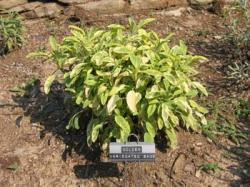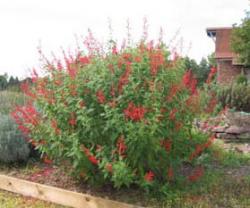Your search for Herbs begining with the letter S returned 46 items.
A | B | C | D | E | F | G | H | I | J | K | L | M | N | O | P | Q | R | S | T | U | V | W | X | Y | Z
Displaying items 1 thru 15
Sage.
Salvia officinalis 'Berggarten'. This pleasantly mounded, compact sage has unusual rounded leaves and is of high ornamental value with a superb fragrance. It was introduced to the U.S. by Allen Bush at his late, lamented Holbrook Farm in North Carolina. It came from the collection of the famous Royal Gardens of Herrenhausen, Hanover, Germany. It produces infrequent flowers. Expect growth to top at about 16 inches and up to 24 inches wide. Space on 20 to 24-inch centers. It is hardy well below 0°F.Sage.
Salvia officinalis 'Tricolor'. This is another colorful variegated sage, unusual for its three colors-white, green, and purple all on the same leaf. It can be used in cooking, but it is essentially a decorative plant. Mature plants are about 18 inches high and 24 inches in diameter. Space on 24 to 30-inch centers. Hardy to about 10° F.Sage, Blue-flowered Common.
Salvia officinalis. Sage is neither as common nor as simple as many of us thought. This is the well-known, blue-flowered garden sage, a centuries old stalwart of the herb garden. Gray-green pointed leaves have a wonderful aroma, perfect for cooking. Plants reach 30 to 36 inches high and 24 to 30 inches wide, and should be spaced on 24 to 36-inch centers. They are hardy to -20°F. Also available in a pink-flowered form.Last Seed Source: www.johnnyseeds.com
Sage, Dwarf.
Salvia officinalis 'Nana'. With a short, compact growth habit, this small-leaved sage is excellent where space is at a premium, either in the garden or in pots on a patio or balcony. Flavorful and is good in a wide range of recipes. Mature plants are about 12 inches high and 18 inches in diameter. Hardy to below 0°F when planted in the ground. Space on 15 to 20-inch centers.Sage, Golden Pineapple.
Salvia elegans 'Golden Delicious'. Like 'Scarlett Pineapple', but with Golden yellow leaves. Dwarf, height to 24 inches.Sage, Golden Variegated.
Salvia officinalis 'Icterina'. Frequently listed in books and catalogs as 'Aurea' which is another cultivar characterized by lime green leaves. 'Icterina' is dazzling shrublet with light green leaves marked with gold margins that rarely flowers. Serviceable in the kitchen. About 18 inches tall and 2 feet wide, this variety is not reliably winter hardy but will withstand temperatures down to 10°F. Space on 24-inch centers.Sage, Honey Melon.
Salvia elegans 'Honey Melon'. Tender perennial. Rounder leaves, more refined aroma, not as pungent as pineapple sage. Bright red flowers appear just before the first killing frost.Sage, Pineapple Scented.
Salvia elegans 'Scarlett Pineapple'. The light green leaves of this sage have a strong pineapple aroma, making it an intriguing novelty. The leaves are commonly used in salads and fruit cups, and a delightful flavored butter is made by mixing in minced foliage. Bright red flower spikes are the plant's contribution to fall color. Mature plants may grow 4 to 5 feet high and are 20 to 30 inches in diameter. It is hardy to about 20°F. Space on 30-inch centers.Sage, Purple.
Salvia officinalis 'Purpurascens'. An abundance of striking purple foliage sets this sage apart, making it a must for the ornamental herb garden. While it is a heavy producer of foliage, it rarely flowers. It is serviceable in the kitchen and especially handy as a garnish. Hardy to somewhere between 10°F and 0°F, it grows 18 inches tall and about 2 feet in diameter.Sage, White.
Salvia apiana. Also called bee sage. The silver leaves release a distinctive aroma during the heat of summer that is difficult to describe. It is not decidedly sweet or musky but something in between. The native americans burned smudge sticks made from this sage.Last Seed Source: www.ivygarth.com
Santolina, Gray.
Santolina chamaecyparissus. Santolina is sometimes called lavender cotton because of its silver-gray foliage. It is one of a class of small shrubs used to edge herb gardens and from which knot gardens are made. When paired with germander's deep green foliage a stunning contrast is created. Historically, santolina was used medicinally and as a moth repellent. Mature plants may reach 2 feet tall.Santolina, Green.
Santolina pinnata. Historically, santolina was used medicinally and as a moth repellent. Mature plants with their dainty, yellow flowers may reach 2 feet tall and may be as wide, if plants are not pruned regularly. Good edging plant, highly aromatic. Flower and foliage may be dried.Savory, Summer.
Satureja hortensis. Summer savory is a bushy annual that grows best with regular use. Cutting stems frequently during the summer will keep the plant vegetative and useful. Known as the bean herb because of the way in which it dresses up the common legume, savory may be substituted for sage in poultry and oregano in most things.Last Seed Source: www.johnnyseeds.com
Savory, Winter.
Satureja montana. Perennial. Height 18 to 24 inches tall and nearly as wide. Savory may be substituted for sage in poultry and oregano in most things. The plant can become woody and sprawling if left unpruned; it is wise to start the spring by removing the top one-third to one-half of each stem to encourage new growth and keep the plant from sprawling.Last Seed Source: www.johnnyseeds.com


